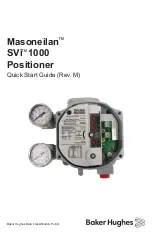
The following accessories are available:
Cable gland M 20 x 1.5
Black
Order no. 1400-6985
Blue
Order no. 1400-6986
Adapter M 20 x 1.5 to ½ NPT:
Aluminum, powder-coated
Order no. 0310-2149
3.2 Pneumatic connections
The pneumatic connections are designed as
tapped holes with ¼ NPT or ISO 2228/1-
G ¼ thread. The conventional male connec-
tions for metal and copper pipes (or plastic
hoses) can be used.
Note:
The supply air must be dry and free of any
oil and dust. Always observe the mainte-
nance instructions applicable to the con-
nected pressure reducing stations. Blow out
air lines thoroughly before connecting them.
3.2.1 Pressure gauges
We recommend attaching pressure gauges
for the supply air and signal pressure in or-
der to monitor the positioner. The parts are
listed as accessories in the table on page
20.
3.2.2 Supply pressure
The required supply pressure is determined
by the bench range and the operating direc-
tion (fail-safe action) of the actuator. The
bench range is written on the nameplate as
spring range or signal pressure range de-
pending on the type of actuator.
FA
(actua-
tor stem extends) or
FE
(actuator stem re-
tracts) or a symbol indicates the operating
direction.
Actuator stem extends (FA)
Fail-safe position Valve CLOSED
(for globe and angle valves)
Required supply pressure =
Upper bench range value + 0.2 bar,
minimum 1.4 bar.
Actuator stem retracts (FE)
Fail-safe position Valve OPEN
(for globe and angle valves)
The required supply pressure for a
tight-closing valve is roughly estimated from
the maximum signal pressure pst
max
:
pst
max
= F + d
p
A
2
4
× ×
×
p D
[bar]
d = Seat diameter [cm]
D
p = Differential pressure across valve [bar]
A = Actuator diaphragm area [cm²]
F = Upper bench range of actuator [bar]
EB 8359-2 EN
11
Connections
Fig. 6 · Electrical connection
Input
control signal
(0)4 to 20 mA
Summary of Contents for 4763
Page 22: ...22 EB 8359 2 EN...
Page 23: ...EB 8359 2 EN 23...
Page 24: ...24 EB 8359 2 EN...
Page 25: ...EB 8359 2 EN 25...































